The Blue House: A Conversation with Phoebe Wahl
 August 12th, 2020 by jules
August 12th, 2020 by jules
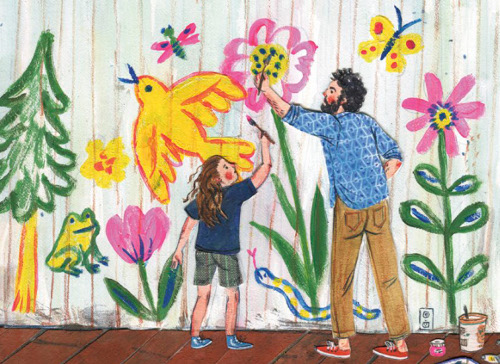
I’ve got a review over at BookPage of Phoebe Wahl’s neweest picture book, The Blue House (Knopf, August 2020). That review is here.
Because this is one of my favorite 2020 picture books, I asked Phoebe if she wanted to talk a bit about the book. (I just noticed that three out of my five questions to her below begin with “I love how ….”) There are a few spreads from the book below, and Phoebe also shares some sketches and in-studio images. I thank her for visiting!
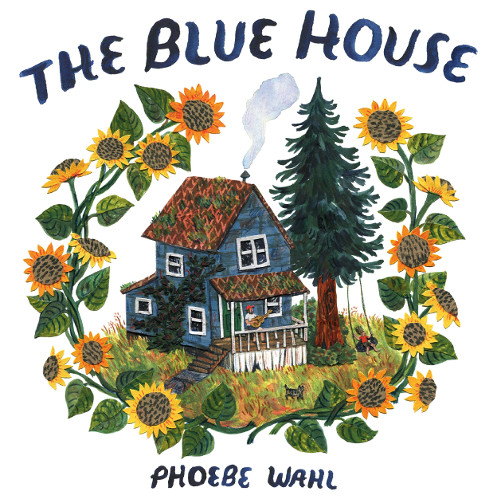
Jules: What was the origin of this story? Is it based on people you know in real life?
Phoebe: It is! It’s based on the experience of my partner and his son. In 2017, they had to move out of the house they’d lived in for six years, when the landlord had sold the property for development. The blue house [in the book] looks almost exactly like the real-life blue house. I only changed a few things about the layout for compositional purposes and altered some story elements for clarity purposes — such as the fact that I don’t exist in the book, and Leo’s mom isn’t mentioned. (In reality, he lives with her half the time.)
I lived part-time at the real-life blue house for two years and had my own emotional attachment to the place. My first date with my partner was at that house. We picked tomatoes and beets and onions from its garden for dinner, and we listened to Everly Brothers records on the yellow floral couch. The house was over a hundred years old — funky and creaky, but such a wonderful home.
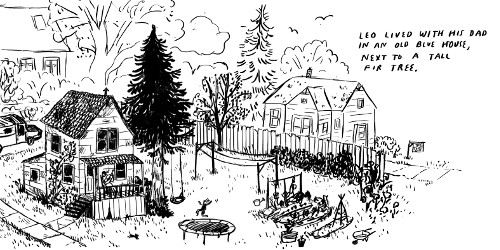
(Click to enlarge)
It was really hard for all of us to leave it behind, but especially Theo (the real-life Leo), since it was where he had lived for the majority of his life. It was extremely surreal once it was torn down. It still is. I actually drove last night by the spot where it once was — and still felt a pang of surprise not to see it there, after three years of it being gone. I have such clear, perfect memories of exactly how the house looked and felt and smelled, where every object was placed. It feels impossible that it just doesn’t exist anymore in that iteration — like the death of a person.
I was in a dry spell after we left the blue house behind, feeling busy and overwhelmed with life and like I’d never have another story idea again. I was telling my friend Jess X. Snow (whose first book The Ocean Calls just came out with Kokila) about it on the phone — how Theo was having a hard time leaving his old house behind, how strange it felt for a place you love so much to be leveled and disappear. And they said, “that sounds like a story for a children’s book right there.” All I needed were those words to spark the story, and I went upstairs and wrote the entire first draft in about 20 minutes. I’m incredibly grateful for the feedback and insight that friends and family often bring into my creative process. I often need another brain to make sense of everything on my own!
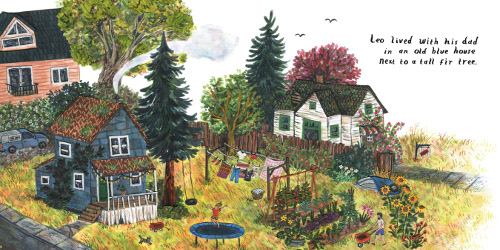
next to a tall fir tree.”
(Click to enlarge and read text in its entirety)
Jules: I love how you depict a loving relationship between father and son here. There’s physical intimacy too. That is, toxic masculinity that would tell them they shouldn’t hug or comfort each other doesn’t get in their way. Was that intentional on your part?
Phoebe: It was definitely intentional to depict that, since it unfortunately isn’t something we see often in male-dominated books. But it wasn’t at all a stretch. My real-life partner and his son are very cuddly and close with one another, so their intimacy wasn’t hard to imagine. It’s something I see modeled all the time, and it felt only right to bring that part of their relationship into the book.
Jules: I love how these characters vent their rage, especially the “special scream solo.” I put in my review that this may be the most punk picture book of the year. I suppose it’s not often that we see characters vent their rage in picture books. Was this also intentional for you?
(Click to enlarge)
Phoebe: Ha! Yes, it was. One of my favorite parts of watching my partner parent is witnessing the ways he facilitates expression through creativity. They often get energy and feelings out through music and art and dancing. I think rage specifically is something we don’t see often in children’s books, but it is such a big part of the experience of being a kid. So many deeper feelings manifest through anger — fear, grief, frustration, lack of control. It wasn’t easy to be patient with that at first, when I started living with my stepson. His anger scared me sometimes, and I just wanted to make him instantly feel better and calm down all the time. It really took tapping into my own memories of anger in my childhood to remember how potent and important of a feeling it is in itself, and realize that sometimes you just need to sit with someone and hold space for their raw emotions, rather than trying to make an instant fix. Only once you honor the feeling they’re experiencing and hear them out can you begin to peel back all the layers of what’s underneath.

They shredded on guitar, and Leo did a special scream solo.
It made both of them a little less mad.”
(Click to enlarge and read text in its entirety)
Jules: I love how the house becomes so real for readers, based on the details you provide. Have you had a favorite house in your life?
Phoebe: I’ve been lucky to have lived many places I love — some gorgeous old spots in Providence during college and a really special stucco craftsman in northeast Portland in my early twenties. But I definitely think the house I grew up in will always occupy the biggest part of my heart. And, more specifically, the house the way it was when I was a kid. My mom still lives in that house, and I still love it. But what I love more is the memory of it and the way that all the little tchotchkes and photos and furniture that she still has have keep that memory alive.
I think, more so than the house itself, it’s the human element that makes a home, the energy and love we bring to spaces, however big or small, and the things we collect — intentionally or not, like yogurt containers! (How many can you find in The Blue House?) It becomes clear when we move. Overnight, a house can turn from a home into just an empty husk of itself, and I wanted to show that transformation. I wanted to show that—while elements of a home can feel fixed and immoveable, like the house itself—so much of what makes it what it is can be carried with you or inside of you. Even though losing the blue house feels like a death, it also lives on in all the objects that we brought to the home we live in now.
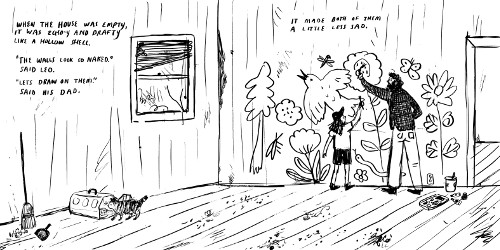
(Click to enlarge)
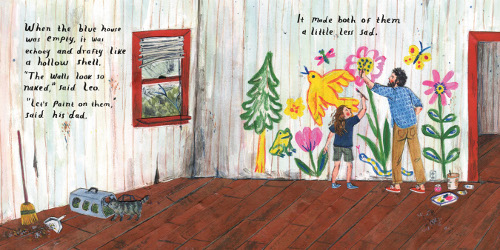
It made both of them a little less sad.”
(Click to enlarge and read text in its entirety)
Jules: Any new books and/or projects you can talk about now?
Phoebe: Right now I’m working on a long, multi-part picture book with Tundra, called Little Witch Hazel. It’s been in the works in some form or another for over three years now, but I’m finally heading into making my final illustrations. This means an end is in sight! It’s about a little gnome witch, who lives in the forest and helps out the other creatures there.
I’ve also been working in my spare time on transcribing my high school diaries. I have a secret ambition to adapt them into some kind of illustrated novel or comic. But I find it incredibly hard to tell whether they’d be entertaining to other people, or if it’s just my personal attachment to those memories that make them interesting. So, we’ll see if anything ever comes of that!
I’ve also been working for the last year on a stop-motion animated adaptation of “Thumbelina,“ called Tulip, with my friend, animator Andrea Love. We just wrapped animation, and it’s now in post-production. We are hoping it will be done in time for film festival submissions by October.
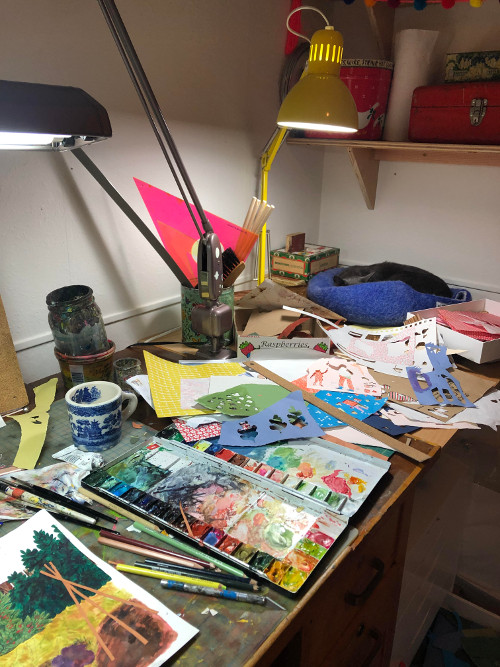
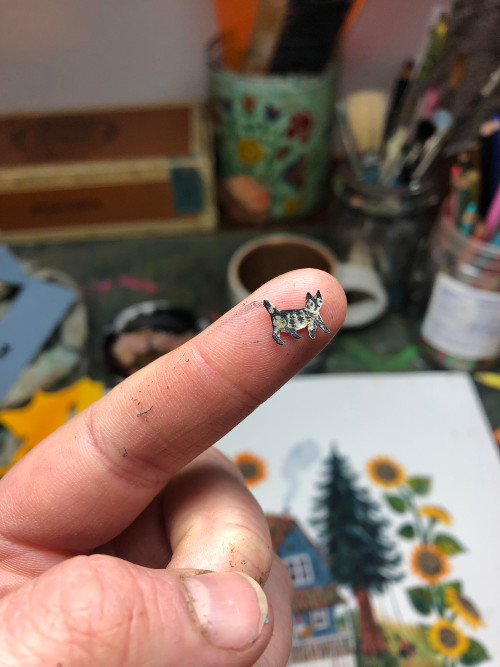
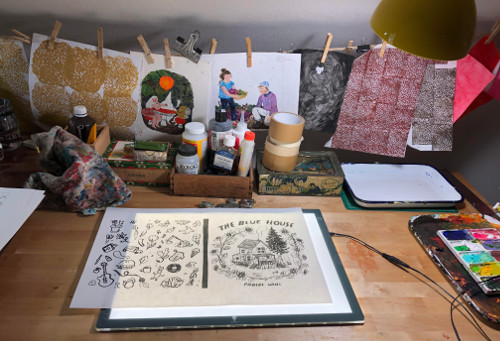
THE BLUE HOUSE. Copyright © 2020 by Phoebe Wahl. Illustrations reproduced by permission of the publisher, Alfred A. Knopf, New York. All other images reproduced by permission of Phoebe Wahl.


Wowww. That’s seriously hardcore collage! And it’s so beautiful!
[…] 這本書是根據 Wahl 的真實經驗寫成,Leo 是她的繼子,有興趣可以讀這篇訪談,裡面還有Wahl創作過程的草圖。http://blaine.org/sevenimpossiblethings/?p=5161 […]